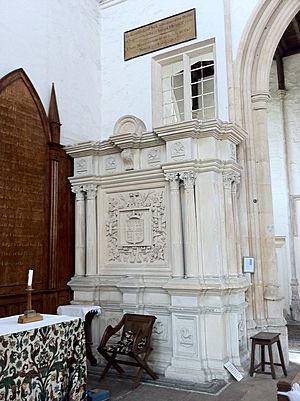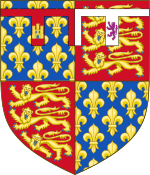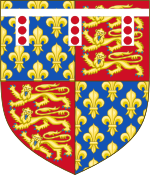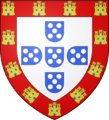Edward, 2nd Duke of York facts for kids
Quick facts for kids Edward of Norwich |
|
|---|---|
| Duke of York | |
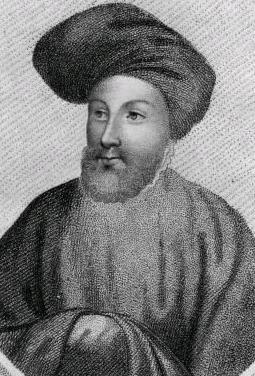
1793 portrait by Edward Harding, after a 15th century original in the chronicle of Jean Creton
|
|
| Born | c. 1373 Langley, Hertfordshire, England |
| Died | 25 October 1415 (aged c. 42) Battle of Agincourt, France |
| Burial | 1 December 1415 Church of St Mary and All Saints, Fotheringhay |
| Spouse | Philippa de Mohun (m. 1398) |
| House | York |
| Father | Edmund of Langley, 1st Duke of York |
| Mother | Isabella of Castile |
| Religion | Roman Catholicism |
| Occupation | Nobleman, soldier, author |
Edward, 2nd Duke of York, born around 1373, was an important English nobleman and military leader. He was the oldest son of Edmund of Langley, 1st Duke of York, and the grandson of King Edward III.
Edward held many important jobs under Kings Richard II, Henry IV, and Henry V. He was also known for translating a famous book about hunting called The Master of Game. Edward died in 1415 at the Battle of Agincourt in France, where he was leading part of the English army.
Contents
Edward's Family and Early Life
Edward of Norwich was born around 1373, probably in Langley, which is now Kings Langley in Hertfordshire. His father was Edmund of Langley, 1st Duke of York, a younger son of King Edward III of England. His mother was Isabella of Castile, daughter of King Peter of Castile.
Edward had a sister named Constance and a younger brother named Richard. Some old records suggest he was called 'of Norwich', but this might have been a mistake for 'of York'.
Serving King Richard II
Edward was made a knight when his cousin, King Richard II, was crowned on July 16, 1377. In May 1387, he joined the special group of knights called the Order of the Garter. Edward was very close to King Richard and received many gifts and important jobs from him, even when he was young.
On February 25, 1390, the King made him Earl of Rutland. Then, on March 22, 1391, he became the admiral of the northern fleet, in charge of ships. He later became the main admiral. In 1392, he joined King Richard's council, a group of advisors. He also went with the King on a trip to Ireland in 1394–95. He was also given the title of Earl of Cork. He used both the titles of Rutland and Cork for the rest of his life.
In the late 1390s, Edward went on important trips to France and other places. He was given many jobs, like being in charge of Dover Castle and the Channel Islands. He also oversaw the Tower of London and the Isle of Wight.
In 1397, Edward was given the important job of Lord High Constable of England. He was part of a group that accused some powerful nobles, including the Duke of Gloucester, of serious crimes. Edward received a lot of land from these nobles after their lands were taken away. On September 29, 1397, he was made Duke of Aumale.
In 1398, Edward oversaw a planned fight between Henry Bolingbroke (who would later become King Henry IV) and the Duke of Norfolk. King Richard stopped the fight and sent both men away from England.
Edward continued to receive more gifts and jobs from King Richard. He was put in charge of the Scottish border and given control of lands belonging to other important families.
In May 1399, Edward went with King Richard to Ireland. While they were away, Henry Bolingbroke returned to England with a small group of supporters. Bolingbroke's army quickly grew. King Richard made a bad decision to split his army. Edward's father, Edmund of Langley, 1st Duke of York, who was in charge of England, surrendered to Bolingbroke. Edward quickly joined Bolingbroke's side as well.
Serving King Henry IV
When Henry IV became King, Edward lost his job as Constable of the Tower. He was also put in prison for a short time and lost his title of Duke of Aumale. However, Edward quickly regained the King's trust. He kept his jobs in the Channel Islands and the Isle of Wight and became a member of the King's council.
Some stories say Edward told King Henry IV about a plot by some of King Richard II's old friends to harm Henry IV. However, other historical records don't mention Edward's involvement in this plot.
In 1400, Edward became the Keeper of North Wales. In 1401, he became the King's representative in Aquitaine, a region in France. In 1402, Edward's father died, and Edward became the Duke of York. His title of Earl of Rutland ended at this time, but he still sometimes used it.
Being in charge in Aquitaine and Wales was very expensive for Edward. By 1404, he had to sell or promise his valuable items to pay his soldiers.
In 1405, Edward's sister, Constance, was involved in a plan to free a young noble from the King's care. She accused Edward of being involved. Edward first denied it but later admitted he knew about the plan. He was arrested and held in Pevensey Castle for 17 weeks. After this, he slowly returned to the King's good graces. His lands were given back to him, and he continued to serve in the military in Wales.
In the last years of King Henry IV's rule, Edward supported the King in disagreements about foreign policy with his son, the Prince of Wales (who would become King Henry V). In 1412, Edward went to France again to help one side in a conflict there.
Serving King Henry V and Death
King Henry IV died in 1413. Edward may have returned to England briefly, but by June 1413, he was preparing for a military campaign in Aquitaine. In August, he was in Paris, helping to arrange a marriage between the new King, Henry V, and Catherine of Valois, the daughter of the French King. Edward was back in England by October and involved in talks before Henry V invaded France in 1415.
Just before the invasion, King Henry V discovered a plot involving Edward's younger brother, Richard. Richard was executed for his part in the plot. Edward himself was not involved. He then went with the army to France.
Edward was at the Siege of Harfleur. He led the front part of the army as they marched through northern France. On October 25, 1415, he led the right side of the English army at the Battle of Agincourt. He was the highest-ranking English soldier to die in the battle. Some say he rushed forward to help King Henry V, who was being attacked, and saved the King's life but lost his own. His death might have been from a head wound or from being crushed in the fighting.
Edward was buried in the Church of St Mary and All Saints, Fotheringhay. The monument there today was put up much later by Queen Elizabeth I.
Since Edward had no sons, his four-year-old nephew Richard, his brother's son, inherited his titles of Duke of York and Earl of Rutland. This Richard later became a key figure in the Wars of the Roses, a series of conflicts for the English throne.
Marriages
Edward married two times but did not have any children.
- First, in 1381, he was betrothed to Beatrice of Portugal, the daughter of King Ferdinand I of Portugal. Edward was only eight years old. This was part of an alliance between England and Portugal. However, the marriage was later canceled, and Beatrice married the King of Castile instead.
- Second, before October 7, 1398, Edward married Philippa de Mohun. Philippa had been married twice before and had no children. She did not bring much wealth to the marriage. This marriage also had no children. Philippa died in 1431 and was buried in Westminster Abbey.
The Master of Game
Edward was King Henry IV's Master of the Hart Hounds, meaning he was in charge of the King's deer hunting dogs. Between 1406 and 1413, he translated a famous hunting book from the Middle Ages called Livre de Chasse. He added five of his own chapters to it. The English version became known as The Master of Game. He dedicated this book to the Prince of Wales, who later became King Henry V.
Titles and Arms
Titles Held by Edward
- Duke of York (1402–1415)
- Earl of Cambridge (1402–c. 1414)
- Duke of Aumale (1397–1399)
- Earl of Rutland (1390–1402)
- Earl of Cork (c. 1395)
Edward's Coat of Arms
As a grandson of the King through his father's side, Edward of Norwich used the royal coat of arms. His first arms, as Earl of Rutland, had a special design to show he was part of the royal family. In 1402, when he became Duke of York, he used his father's arms, which also had a special design to show his royal connection.
Edward in Shakespeare's Plays
Edward of Norwich appears as a character in two of William Shakespeare's plays.
In Richard II, he is called the Duke of Aumerle. His death at Agincourt, as the Duke of York, is shown in Shakespeare's Henry V. Interestingly, the plays don't mention that the Duke of Aumerle in Richard II and the Duke of York in Henry V are the same person.
Images for kids
-
Arms of King Ferdinand I of Portugal


